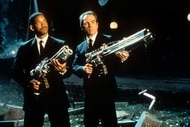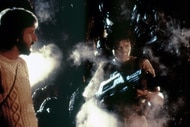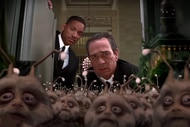Is Ghostly Electronic Voice Phenomena (EVP) Real? The Science Behind White Noise
Are there messages hidden in radio static?

The 2005 supernatural horror movie White Noise (now streaming on Peacock) hinges on the concept of electronic voice phenomena or EVPs, the idea that ghosts communicate with the living through electronic noise. There’s no reliable scientific evidence for supernatural missives hidden in radio static, but scientists have uncovered messages from the universe itself, embedded in the white noise.
In the film, Michael Keaton plays Jonathan Rivers, a man whose wife, Anna, disappears under mysterious circumstances. With the search still ongoing, Rivers meets a man called Raymond Price (Ian McNeice) who introduces him to the notion of EVPs. Price claims to have captured a recording of Anna’s voice, suggesting she isn’t just missing, she’s dead. When Anna’s body is discovered soon after, Rivers feeds an obsession for connecting with the other side, with dangerous consequences.
Explaining Electronic Voice Phenomena (EVPs), as portrayed in White Noise
In supernatural circles, white noise, electronic noise, or static is seen as a tool for communicating with the beyond. There are various designs for capturing these ephemeral communiques, but they all rely on the belief that ghosts, spirits, demons, and other non-corporeal entities can manipulate electrical devices and signals to create meaning.
Some EVP devices are simply radios tuned to a frequency between stations. Others are radios modified to continually scan through every AM and FM frequency. In this way, the listener ends up hearing static punctuated by snippets of songs, conversations, or advertisements being broadcast by radio stations. Others work by raising the noise floor, turning up the electrical noise created by the device itself, resulting in what sounds like open vowels.
People then listen to the sounds either produced or captured by their device and listen for words or phrases from unseen sources. Outside of supernatural circles, EVPs are easily explained by pareidolia, the tendency for the brain to find meaning or patterns in otherwise meaningless data. It’s the same phenomenon that makes us see shapes in the clouds or faces in Martian geology. EVPs have been described as a sort of auditory Rorschach test, which says more about the listener than any apparent meaning in the actual recordings.
What is radio and TV static?
Your radio or analog television doesn’t know what it’s picking up. These are devices equipped with instruments for detecting and translating RF (radio frequency) signals. Radio signals get transmitted over the air and picked up with the TV or radio antenna.
As its name suggests, the tuner allows you to tune the antenna to pick up specific frequencies, letting you narrow in on a particular station or channel. It works because the station broadcast on that frequency is stronger than the ambient radio background noise. When you tune into a channel that doesn’t have an active transmission, either an empty channel or between stations, the antenna picks up that ambient background noise and presents it the best way it can, as static.
We are awash in radio waves all the time; we just can’t see or hear them without the right tools. They come from atmospheric interactions, from lightning, and from the Sun. Some of them are left over from the birth of the universe, a space-time birthmark known as the cosmic microwave background.
When you turn on a radio or television to a vacant frequency, you’re picking up all of that natural radio noise along with signal interference from other electrical devices, thermal noise from the radio or TV itself, and a host of other environmental sources. It’s the chaotic radio chorus of reality presented to you in audiovisual form. In a way, static does hold messages from ghosts, not of people but of stars and of the universe itself.
Catch White Noise, streaming now on Peacock.



























